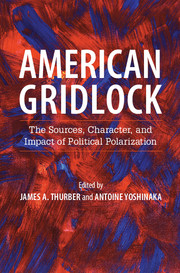Book contents
- Frontmatter
- Dedication
- Contents
- List of contributors
- Foreword
- Acknowledgments
- Introduction
- PART I POLARIZATION AMONG VOTERS AND ACTIVISTS
- 1 The New American Electorate: Partisan, Sorted, and Polarized
- 2 Redistricting and Polarization
- 3 Party Activists, Interest Groups, and Polarization in American Politics
- 4 Authoritarianism and Polarization in American Politics, Still?
- 5 Party Sorting: The Foundations of Polarized Politics
- PART II POLARIZATION IN NATIONAL INSTITUTIONS
- PART III POLARIZATION IN THE STATES
- PART IV POLARIZATION IN THE MEDIA
- PART V IMPLICATIONS AND CONCLUSIONS
- Index
- References
3 - Party Activists, Interest Groups, and Polarization in American Politics
from PART I - POLARIZATION AMONG VOTERS AND ACTIVISTS
Published online by Cambridge University Press: 05 November 2015
- Frontmatter
- Dedication
- Contents
- List of contributors
- Foreword
- Acknowledgments
- Introduction
- PART I POLARIZATION AMONG VOTERS AND ACTIVISTS
- 1 The New American Electorate: Partisan, Sorted, and Polarized
- 2 Redistricting and Polarization
- 3 Party Activists, Interest Groups, and Polarization in American Politics
- 4 Authoritarianism and Polarization in American Politics, Still?
- 5 Party Sorting: The Foundations of Polarized Politics
- PART II POLARIZATION IN NATIONAL INSTITUTIONS
- PART III POLARIZATION IN THE STATES
- PART IV POLARIZATION IN THE MEDIA
- PART V IMPLICATIONS AND CONCLUSIONS
- Index
- References
Summary
• Parties are more than their formal structures. They cannot be understood without attention to the role of both activists and party-aligned interest groups.
• The policy preferences of activists and interest groups are both shaped by and shape the behavior of elected officials. Sometimes activists and lobbies take cues from politicians, but their actions also reinforce and contribute to polarization in important ways.
• The polarization of Democrats and Republicans reflects the incorporation of new groups in party coalitions since the 1970s.
Polarization is visible in many aspects of American politics, from Congress to the courts to state legislatures and even the electorate. The common thread linking all of these settings is political parties. Polarization is a party story. Yet understanding American parties is a challenging endeavor. Parties, unlike the branches of government or even the electorate, are not well-bounded entities. Individuals and groups with no formal role or place on the organization chart play important roles in parties.
In this chapter, I argue that activists and interest groups are key elements of political parties. Activists and party-aligned interest groups work within parties to advance their policy goals via candidate selection and lobbying elected officials. Unlike the formal party structure and some elements closely linked to it, activists and interest groups are a force for polarization. I review delegate and donor surveys as well as trends in interest group campaign contributions revealing evidence of polarization among activists and lobbies. Elected officials’ relationships with party activists and interest groups are not one-sided. Even more than highly informed voters, activists take cues from politicians, and interest group leaders are subject to pressure from elected officials. Still, evidence suggests that activists and party-linked interest groups promote polarization.
AMERICAN POLITICAL PARTIES: REVIVED AND POLARIZED
American political parties, once seen to be in terminal decline, have been reinvigorated in recent decades. In the same period that polarization emerged, party organizations have grown far better funded and staffed (Herrnson 2013). Mann and Corrado (2014) find that in the 1976 campaign, the Democratic National Committee (DNC), Democratic Senate Campaign Committee (DSCC), and Democratic Congressional Campaign Committee (DCCC) raised $52.8 million, $4.1 million, and $3.8 million, respectively (all sums are in 2012 dollars). By 2012, the DNC, DSCC, and DCCC raised $290.4 million, $145.9 million, and $183.8 million in 2012 dollars, respectively.
- Type
- Chapter
- Information
- American GridlockThe Sources, Character, and Impact of Political Polarization, pp. 68 - 85Publisher: Cambridge University PressPrint publication year: 2015
References
- 7
- Cited by



